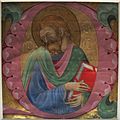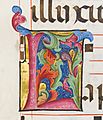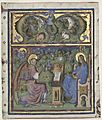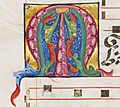Belbello da Pavia facts for kids
Belbello da Pavia, also known as Luchino Belbello from Pavia, was an Italian painter who lived from about 1430 to 1470. He was famous for his beautiful illuminated manuscripts, which are books decorated with colorful pictures and designs. Belbello was born in Pavia, a city in Italy, but later moved to Milan. There, he caught the eye of Duke Filippo Maria Visconti, a powerful ruler.
The Duke asked Belbello to continue working on a very special book called the Book of Hours of Gian Galeazzo Visconti. Belbello worked on this book at different times in his life, and you can see how his painting style changed over the years. Around the same time, he also helped illustrate a Bible for Niccolò d'Este. Later, Belbello moved to Mantua and started painting a Missal (a book used for church services) for Gianlucido Gonzaga, a member of the noble Gonzaga family. He had to leave Mantua in 1450 and went back to Pavia. In 1461, the Marchioness of Mantua, Barbara of Brandenburg, gave his work on the Missal to another artist. After trying unsuccessfully to get his job back, Belbello moved to Venice in 1462, where he lived until he passed away.
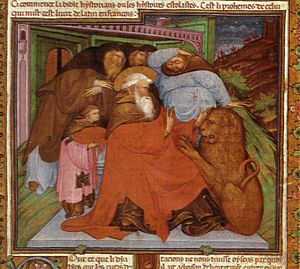
Contents
- Belbello's Journey and Art Style
- How Belbello's Work Was Rediscovered
- Belbello's Important Artworks
- Other Notable Works
- The Mission of the Apostles
- St. Augustine- Initial I
- St. Julian (or St. Paul?)- Initial S
- St. Paul- Initial S
- An Apostle (or Martyr Saint?)
- St. Stephen- Initial E
- St. Margaret- Initial C (?)
- Holy Bishop
- Old Bearded Saint with a Book- (St. John the Evangelist?)- Initial M
- Seated Evangelist- Initial S(?)
- St. George?
- St. Catherine of Alexandria (St. Justine or Padua?)- Initial R
- Old Man in Prayer with a Youth Behind Him (Saul and David?)- Initial S
- St. Mary Magdalene- Initial G
- Other Notable Works
- Images for kids
- See also
Belbello's Journey and Art Style
Belbello's early life is not well known, including his exact birth year or how he first learned to paint. We only know for sure that he was born in Pavia. When he was young, he moved to Milan and met Duke Filippo Visconti.
While still working on the Book of Hours, Belbello also illustrated a Bible for Niccolò d'Este. Another artist, Jacopino, later finished this Bible. Around 1448, Belbello was in Mantua, working on a Missal for the Gonzaga family. He had to leave Mantua in 1450 and returned to Pavia. Even after leaving, he stayed in touch with the Gonzaga family.
In 1461, Marchioness Barbara of Brandenburg decided that Belbello's work on the Missal was no longer what she wanted. She gave the job to a younger artist named Girolamo da Cremona. Belbello tried to get his work back, but he was not successful. In 1462, it seems he briefly worked for the Duchess of Milan.
After 1461, Belbello's art style changed. It became grander and started to show influences from the Renaissance art movement. This change might have been because he was replaced by a younger artist whose style was more modern. His later works show how he dealt with getting older and how public tastes in art were changing. Belbello then likely returned to Venice, where his style remained popular until his death.
Belbello was part of a group of artists in Pavia who specialized in miniature painting. His style was influenced by artists from the Lombardy region, like Michelino Molinari da Besozzo, and also by French miniature painters. Some of his work also shows influences from Michele Giambono, especially in how he placed figures in his paintings.
How Belbello's Work Was Rediscovered
For a long time, Belbello's art was not recognized. It wasn't until the early 1900s that an art historian named Pietro Toesca connected the style of paintings in the d'Este Bible to the illustrations in the Visconti Hours. Before Toesca's discovery, many of Belbello's works were mistakenly thought to be by French artists or other Italian artists like Giovanni di Paolo.
Toesca used letters from the Gonzaga family that talked about the artist who worked on a Missal. This helped him identify Belbello. In 1930, Toesca thought 12 works from a collection were by a follower of Belbello. But in 1951, Professor Mario Salmi confirmed that Belbello himself had created them.
There was some debate about a specific page (fol. 57v) in the Visconti Hours. Toesca believed it was by Belbello, but others disagreed because its style seemed different. Mirella Levi D'Ancona, an art expert, suggested that the difference in style was because the work was done at a later time. She believed it was started after the Duke's death in 1447, and Belbello finished it when he returned to Pavia in 1461.
An artist known as the "Master of Murano" was later identified as Belbello himself. This artist was known for influencing other painters and for his unique way of painting fabric folds.
The Master of the Murano Gradual
Some artworks once thought to be by Belbello are now believed to be by a close artist he worked with, known as the "Master of the Murano Gradual." This artist used Belbello's style but made figures look more solid and serious. His name comes from a type of choir book, called a gradual, that he worked on. This book is thought to have come from a monastery in Murano, Italy.
An artwork called "Initial I with the holy Pope" was first thought to be by Belbello. But now, experts believe it was done by a possible student or artist who came after Belbello, perhaps from Venice. This piece has Belbello's humor and elegance but is also more serious.
Followers of Belbello
The paintings known as Sts. Cosmas and Damian- Initial O were not made by Belbello, but they look very similar to his work. They were likely created by one of his followers, who might have also worked with Belbello on another book in Venice. This follower might have been from Padua or Bologna. Unlike Belbello, this artist used strong shadows and clear shapes in his work. These paintings also lack the bright colors Belbello was known for.
Belbello's Important Artworks
Belbello's earliest and most important work was his part in the Book of Hours of Gian Galeazzo Visconti. Duke Filippo Maria Visconti gave him this job. The book was started in 1390 by Giovannino de Grassi and his son, but their work was stopped twice when they died. Belbello took over in 1412.
The Visconti Hours shows that Belbello already had a developed style, even though he tried to copy the artists who worked on the book before him. However, his work in the book is not all the same, with different styles appearing throughout. Some art historians believe these differences might be because Belbello had assistants helping him. Today, the Book of Hours is kept in two different collections: one in Milan and another in Florence.
Belbello also worked on a Breviary (a prayer book) for Marie of Savoy, Duchess of Milan in 1432 and the Estense Bible in 1434. The Bible shows his unique way of telling stories through art.
His later important works include a Gradual (another choir book) for Cardinal Bessarion and a Roman Missal for the Mantua Cathedral. In these works, his figures became fuller and more dramatic. He created Illuminated manuscripts for important people in northern Italy, using a unique style inspired by the International Gothic art movement.
In the Bible for Niccolò d'Este (1431-1434), Belbello painted large figures with flowing lines and bold movements, using bright colors. Throughout his long career, Belbello mostly stuck to the Gothic style, but he also updated it to fit the tastes of his audience. He passed away around 1470.
Other Notable Works
The Mission of the Apostles
This painting shows the Apostles praying after the death of the Virgin Mary and Pentecost. They are deciding to spread the Christian message around the world. This scene is special because it's rarely shown separately from Pentecost. You can tell the difference because the Virgin Mary is not there, and the setting is different from where the Holy Spirit came down.
Belbello chose a rocky landscape for this scene. The Apostles are praying, and the Dove of the Holy Spirit is coming down to them. Even the trees seem to bend as if they are praying, and rabbits hide in their burrows. You can spot St. Peter in the middle, showing his important role in the church, and St. John the Evangelist, who looks young and holds the Book of Revelation. The painting includes 13 apostles, showing that Belbello accepted St. Paul as an Apostle, even though he joined later. St. Barnabas is also shown, replacing Judas.
This artwork goes with a hymn and has the first word of the hymn in its frame. The painting was likely made for a Benedictine monastery. It shows black-robed monks (the original Benedictine robes) and white-robed monks (reformed Benedictines). The painting's colors are light and bright, and its frame looks like a painted wooden frame with black, green, and red colors and blue stones.
St. Augustine- Initial I
This painting likely comes from the beginning of a church service for St. Augustine. The letter "I" is decorated with blue and pink leaves, a style that might have come from Florence. St. Augustine wears a black robe, which is what Augustinian monks wore, and a white hat called a miter. He holds a pale blue book. His skin has a brownish color, and his white facial hair stands out.
St. Julian (or St. Paul?)- Initial S
This painting shows a saint who looks directly at you. He holds something that looks like a mix between a sword and a cross. Some thought he was St. Paul, but his clothes are different from St. Paul's usual attire, and he doesn't have St. Paul's pointed beard. The object he holds might be a dagger, which relates to the story of St. Julian, who accidentally killed his parents with a dagger. St. Julian became a saint after a life of good deeds. However, experts are not fully sure about this identification because it's not clear if it's a dagger, and St. Julian is usually shown as a young man.
The saint wears a pinkish garment with black sleeves and a red cloak with green lining. His hair and beard are yellowish-brown, and his face seems a bit damaged. The letter "S" is blue with pink and brown leaves.
St. Paul- Initial S
This painting shows St. Paul as an older man, pointing to the sky. The sword in his left hand is his symbol. St. Paul was once an opponent of Christianity but became one of its most dedicated followers after his conversion. He was arrested in Rome and was beheaded because he was a Roman citizen. The sword became his symbol in art.
Belbello shows St. Paul with a greenish cloak, orange lining, and gold embroidery. He holds a gray sword. His hair is yellowish-brown, his skin is tan, and his pointed beard helps identify him. The letter "S" is a mix of orange-red, pink, green, and blue, and the gold background is flaking.
An Apostle (or Martyr Saint?)
This figure might be a saint, possibly St. John or St. Philip, or just a Christian martyr. He wears an Apostle's clothes, but leaves seem to grow from his hands, which could mean he is a martyr (someone who died for their faith). We don't know where this image originally came from, so it's hard to identify the saint. It likely came from a choir book.
The saint wears a red tunic with a white border and a green cloak lined with pink. His skin is dark tan with white highlights. The colorful leaves (red, green, blue, pinkish-brown) come from his hands. The gold background shows signs of damage.
St. Stephen- Initial E
The stones on his head and shoulders identify this figure as St. Stephen, as stones were the weapon used to kill him. His youth and clothing also help identify him. Belbello shows flattened stones on his shoulders, and the one on his head has blood dripping from it.
St. Stephen wears a blue robe with gold lining and a purplish neckband. His sleeves are red and purple. The letter "E" around the saint is red with green leaves and pink designs.
St. Margaret- Initial C (?)
The dragon in this painting tells us it's St. Margaret. In her story, she was swallowed by a dragon but came out unharmed. Belbello painted her mouth open, probably to show her thanking God, but it creates an interesting look with the dragon. The colors are bright, with the green dragon standing out against the orange-red and blue letter. St. Margaret wears a pink dress with blue lining and a brownish-gold cloak. The background is gold with leaves. She doesn't look as gentle as female figures usually did back then. Daisies in the background might hint at her name, as "margherita" means daisy in Italian.
Holy Bishop
Like "An Apostle," it's hard to know exactly who this figure is. The saint seems to be holding something, but his hand is empty. It might have been the three golden balls that symbolize St. Nicholas of Bari. However, it could also just be a general representation of bishops. The painting is damaged, with the top part of the bishop's staff missing. The saint wears a light brown cloak with white and red designs, and a white hat with green and blue lining. The letter itself is incomplete, so we can't tell what letter it is, but it's a faded gray with blue lining and red and green leaves.
Old Bearded Saint with a Book- (St. John the Evangelist?)- Initial M
This painting shows an older saint wearing a blue robe and a pink cloak with green lining. He holds a book against the blue and white letter "M." The background is gold with engraved flower designs. His halo is red. He might be St. John, who lived to old age after surviving attempts to kill him. If so, the book would be either the Book of Revelation or the Fourth Gospel. However, his clothes are not the traditional red or pink cloak usually seen on St. John.
Seated Evangelist- Initial S(?)
This painting has a more Venetian feel than Belbello's other works, with a deep red background instead of gold. It also shows some influence from the Venetian painter Michele Giambono, especially in how the fabric flows and the figure's messy hair. The gold designs in the background were a style popular in Venice. This suggests Belbello spent his later life in Venice.
The saint himself has a solid, bumpy look that contrasts with the flowing clothes. Some typical Belbello qualities are there, like the frown and sideways glance, and the bright colors. The saint wears a gray-green lined cloak and a blue tunic with a red and gold band. The throne looks like inlaid wood with red and blue designs, and the floor is red-tiled. The saint's gold halo looks solid. Unlike many of his other works, this painting shows the full length of the figure.
St. George?
This painting is quite damaged, but the head is preserved and might belong to St. George. The saint seems to have worn gold armor with a white robe decorated with a gold cross, and a red-lined gold cloak. However, because of paint loss, these details are mostly gone. What is visible is a white flag with a red cross. There are many warrior saints, so it's hard to be sure who this is. It's thought to be St. George because he is a very common warrior saint in art. Also, St. George is the patron saint of the Monastery of S. Giorgio Maggiore in Venice, where Belbello worked later in life. The letter is too damaged to identify, but it might have been an "N."
St. Catherine of Alexandria (St. Justine or Padua?)- Initial R
This painting shows a noble female saint, identified as St. Catherine. However, it's hard to be certain because there are no clear symbols to distinguish her from St. Justine. The figure holds an open book and has a sword in her chest, with a palm branch that has dates on it. St. Catherine's story says she was tortured on a wheel but was miraculously saved, then beheaded. The dates on the palm might refer to St. Catherine's origins in Egypt. Belbello might not have known much about anatomy, as the sword is on the wrong side of her chest. Because the wheel is missing and a sword is present, some experts thought she was St. Justine, who was often shown with a sword in her neck.
The letter "R" is blue with a white design and green leaves. She wears a green dress and a pink cloak with gold stars and embroidery, and a gold crown with jewels. Her clothes fit tightly. Belbello used shading to make the colors and materials look real. This work shows how he adapted his style to fit the time and audience, and it's one of his few pieces that fully uses the Renaissance style. He aimed to show an ideal type of beauty in a peaceful state.
Old Man in Prayer with a Youth Behind Him (Saul and David?)- Initial S
This painting shows an older man who seems to be in pain, twisted and looking up to the heavens in prayer. The letter "S" seems to follow his movement. A younger person behind him fills the empty space, offering his hand. His presence makes the tense atmosphere a bit less intense. Although his identity is unknown, he looks a bit like St. John in another museum. Some think the old man might be King Saul, repenting for how he treated David, but he doesn't wear a crown, and the youth doesn't have David's harp.
The "S" is orange-red with gray, green, and blue leaves. The old man wears a blue robe with darker blue shades. The youth wears a green garment and has brown hair. Both figures have striking white in their eyes that stands out against their skin color.
St. Mary Magdalene- Initial G
The box of ointments the figure holds identifies her as St. Mary Magdalene. Her figure seems to combine Belbello's usual style with the more solid look of his other figures, possibly from his latest period. This figure looks a lot like those by Lorenzo Monaco, showing how other artists influenced Belbello.
She wears a green dress with red lining and gold decorations, and a gold cloak with pink lining. The letter "G" surrounds her figure and is blue with a red inner rim. Like many of Belbello's works, there's a gold background behind the figure.
Images for kids
See also
 In Spanish: Belbello da Pavía para niños
In Spanish: Belbello da Pavía para niños


